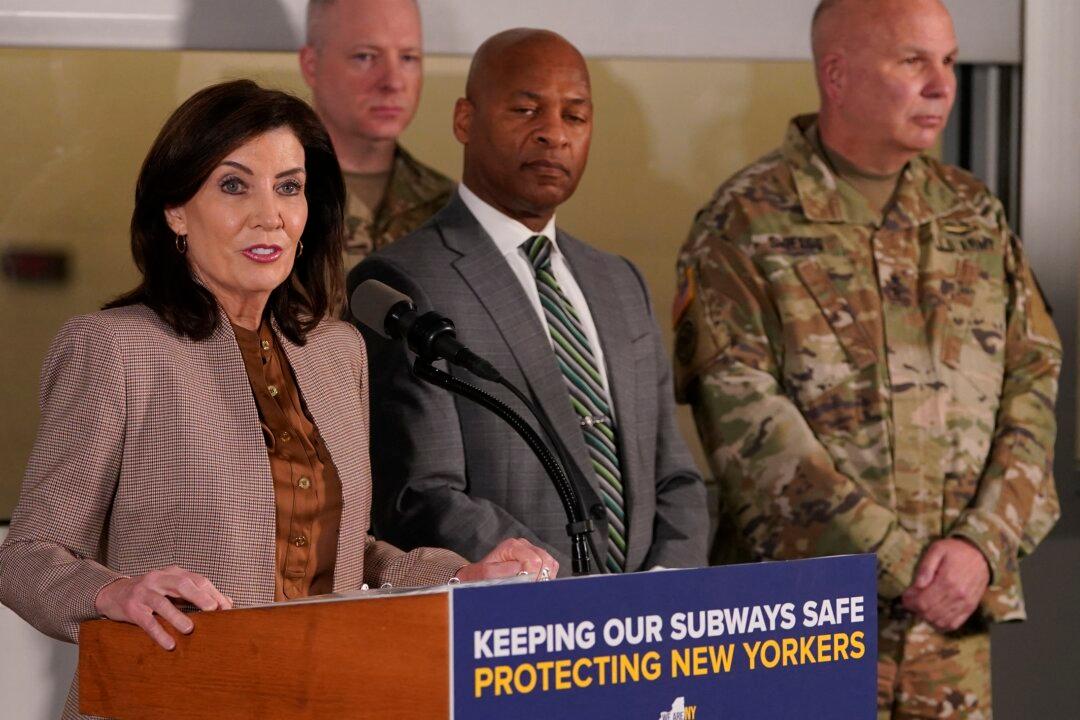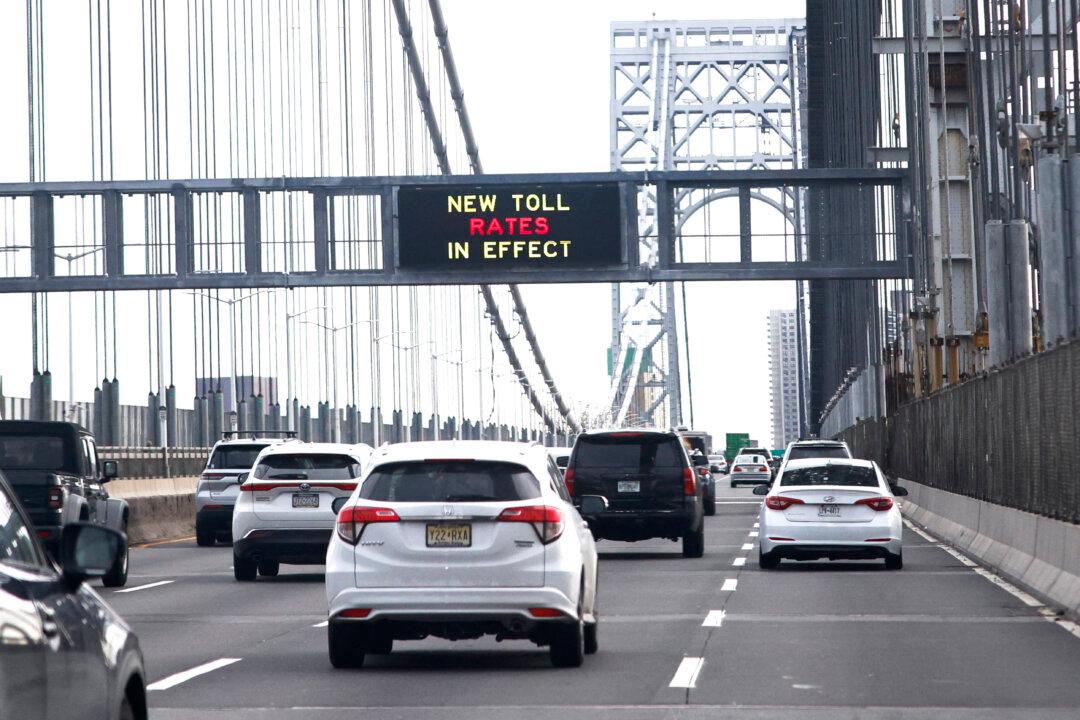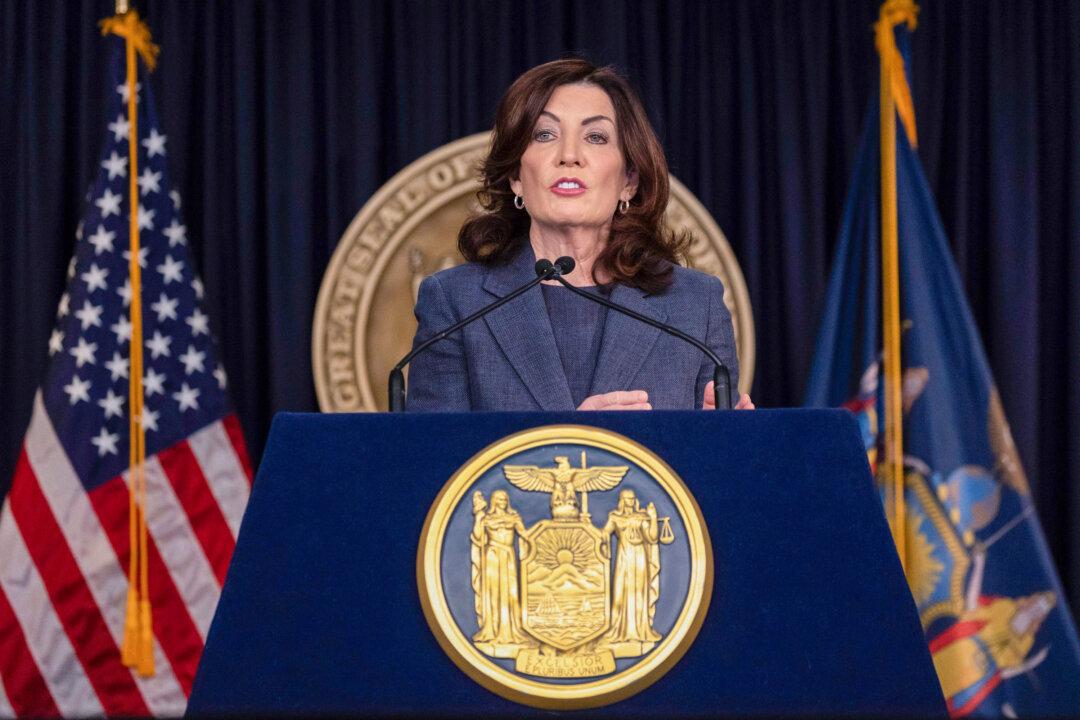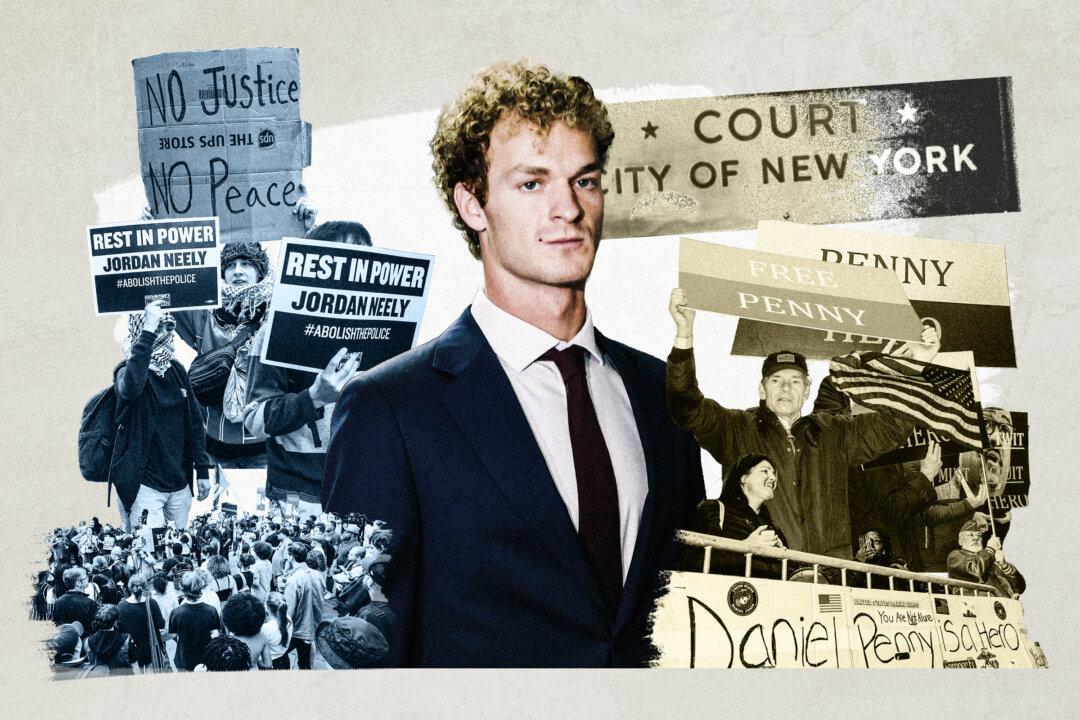NEW YORK—Facing a critical election year and constant evidence of the progressive rollback of tough-on-crime policies, New York Gov. Kathy Hochul and other Democrat leaders are scrambling to counter the narrative that theirs is the party of lawlessness and disorder, some experts say.
In doing so, whether they wanted to or not, these politicians and officials have taken steps toward a more traditional approach to law enforcement.
Ms. Hochul’s abrupt deployment of 700 National Guard troops—along with additional New York State Police and Metropolitan Transit Authority (MTA) officers in the subways of the nation’s largest city—is one such example, in the view of Heather Mac Donald, a fellow at the Manhattan Institute think tank.
“Gov. Hochul is belatedly reacting to the crime and disorder that have plagued New York City since the George Floyd race riots,” Ms. Mac Donald told The Epoch Times.
“Why is she reacting now? Because the November elections loom and Democrats, from the president on down, are vulnerable to the charge that they have enabled a breakdown of law and order.”
Though the beefed-up security presence may have a short-term psychological impact on some commuters and residents, experts say it is unlikely to prove effective in an environment altered since the 2020 riots and defined by bail reform, heightened sensitivity to potential litigation, and the general demoralization of the law enforcement community.
Ms. Mac Donald cited figures that give a sense of the scope of the crisis that New York faces: Homicides rose 23 percent from 2019 to 2023, and shootings went up 27 percent during the same period. Petty larceny climbed 24 percent.
In New York, the Bail Elimination Act of 2019 was enacted at the beginning of 2020. The act ended the use of monetary bail and “unnecessary pre-trial incarceration,” all to promote “equity and fairness in the criminal justice system.”
Harvey Kushner, chair of the criminal justice department at Long Island University in Brookville, New York, largely blames the increase in crime on the above-mentioned bail reform law.
“If you take a look at who commits the crime in New York and on the subways, it’s the very same people, and they’re soon released,” Mr. Kushner said.
“A lot of it is a core group of 200 to 300 individuals. These people get arrested, and then they’re let out on the street immediately,”
“So let’s call this what it is.”
On Feb. 13, a woman, later identified in media reports as Amira Hunter, walked up behind a musician playing a cello in the Herald Square subway station and, seemingly without provocation, allegedly bashed him in the back of the head with a metal water bottle.
It shocked and outraged citizens when the same attacker, released without bail despite the violent offense, allegedly stole clothing from a Nordstrom store just days later.
Many Gothamites still do not feel safe and some are taking matters into their own hands.
On March 14, a 36-year-old man on the train assaulted a 32-year-old stranger, who then wrested away the attacker’s gun and shot him with it. A video of the incident, a microcosm of the crisis in the Big Apple, went viral.
Then, on March 25, yet another incident made headlines.
A suspect identified as 34-year-old Guy Rivera, who was out on the street despite having a record with 21 prior arrests and five years in prison, shot and killed a young NYPD detective and father, Jonathan Diller, during a traffic stop in Queens.
At a wake for Officer Diller, a family member enraged at bail reform and the governor’s perceived lenience on the issue of public safety, confronted Gov. Hochul and said: “You have blood on your hands.”
Constant attacks on the integrity and fairness of policing have emboldened lawbreakers and made many people averse to even thinking about a career in law enforcement, Ms. Mac Donald and others have told The Epoch Times.
Recent weeks and months have seen images of mob attacks by illegal immigrants on hapless visitors in Times Square and of teens rioting in Chicago in the weeks immediately following the election of left-leaning mayor Brandon Johnson in the city’s April 2023 runoff election.

Other Democrat-led cities such as San Francisco, Los Angeles, and Washington, have also struggled with growing homelessness and crime.
With the November 2024 election on the horizon, Democrat leaders are eager to obfuscate or hide their role in allowing crime to spiral out of hand, lest their party pay a crippling price at the polls, Ms. Mac Donald and others say.
Hochul’s Order
While more than a few New Yorkers have been in dangerous situations before, incidents in the subways and on the streets of their city have captured headlines with regularity.
The fact that New York’s controversial bail reform, which took effect Jan. 1, 2020, enabled a violent suspect to continue her crime spree strikes Mac Donald and others as a perfect example of what is wrong with the current system.
On Feb. 14, a homeless man physically assaulted an MTA worker who tried to wake him up on a subway platform and then attacked a bystander who intervened.
In another incident, a 16-year-old boy was left with a knife wound to the upper thigh in a Coney Island subway station.
Then, on the morning of Feb. 15, a young tourist from Brazil became a victim of random, unprovoked violence when a stranger slashed him in the neck in the Queens Plaza station.
On Feb. 17, an attacker repeatedly struck a stranger in the head with a metal pipe in a Queens subway station, placing the victim in the hospital with multiple cuts.
Ms. Hochul’s plan also calls for expanded surveillance and tighter coordination among law enforcement agencies.
Among the provisions of the plan are added personnel to conduct bag checks at crowded areas; a bill that will enable judges to ban people convicted of assaulting transit workers and riders from further use of public transportation in the city; stepped-up coordination among district attorneys, transit personnel, and police; the installation of cameras to monitor conductor cabins; and a $20 million investment in teams for intervention in cases involving mentally ill individuals.
Some observers have praised the governor’s move as a show of force wholly appropriate in a tense and fearful environment.
“As seen a few days ago [in the March 14 rush-hour incident], specific subway stations during congested times make all commuters and transit workers vulnerable to danger, criminal or not. Increased traffic demands increased awareness and teamwork,” David Carlucci, a former New York State senator and a commentator on the state’s political scene, told The Epoch Times.
“This is an all-hands-on deck scenario, and Gov. Kathy Hochul is using the tools and people at her disposal to ensure the safety of all. We cannot count on the great MTA staff to handle increasing traffic and incidents of violent crime.”
Mr. Carlucci acknowledged concerns about the militarization of the MTA as valid, but said the plan also includes mental health teams working alongside the National Guard.

‘Broken Windows’ Approach
The governor’s move marks a partial return to the strategy long associated with someone many progressives now despise: former New York City Mayor Rudy Giuliani, who served from 1994 to 2001.During those years, New York City began to make a tentative comeback from the skyrocketing crime and rampant disorder of the administration of Democrat Mayor David Dinkins, whose tenure ran from 1990 through 1993.
One of the most traumatic events in modern urban history, the Crown Heights riot of August 1991, happened on Mr. Dinkins’s watch, as did the peak of the city’s homicide rate.
In the first year of his tenure, 1990, the city saw 2,245 killings.
One year into his tenure, Mr. Dinkins had failed to make good on his promises to get crime under control.
Mr Giuliani, and his police commissioner, William Bratton, sought to reverse the trend through the policy known as “broken windows.”
The theory was that acting vigilant toward minor offenses would lead to the snaring of criminals with outstanding warrants, who had committed or would soon commit more serious crimes.
John DeCarlo, director of the master’s program in criminal justice at the University of New Haven, the theory that researcher George Kelling developed back in the 1980s was a sound one.
“Look back to 1994, when Bratton used the theory called ‘broken windows’ to address crime in the subway, on George Kelling’s theory that serious criminal offenders were committing minor crimes in the subways.
“That seems to have held true. They had buses outside the major subway stations and they would grab fare-jumpers, take them away, and many of them had pending warrants, so they would remove them from the system,” Mr. DeCarlo told The Epoch Times.
But progressive reforms worked directly against the aggressive stance that Mr. Giuliani, and to a lesser extent, his successor Michael Bloomberg, had followed.
Safety or Waste of Money?
Some observers believe that a strategy best described as police saturation will bear fruit, for the simple logistical reason that criminals will shy away from committing illegal acts when getting caught is a near certainty.“You can put in surveillance, and try to have a well-maintained environment. But the biggest deterrent to crime are people, whether police or the National Guard or state cops.
“The 700-odd National Guardsmen will vet those coming into the system, doing the equivalent of watching for turnstile jumpers, as the police did in 1994,” Mr. DeCarlo said.
“It worked in 1994, and the technology that criminals are using now in the subways hasn’t advanced.”
Other experts are less sanguine about Ms. Hochul’s approach.
The crackdown is too little, too late, they say, and the political factors underpinning it are blatant.
Jeffrey Fagan, a criminologist who teaches at Columbia Law School, said the governor’s approach is not only arbitrary but will reignite many of the controversies that have dogged law enforcement in the recent past.
“Subway crime is like a needle in a haystack,” Mr. Fagan told The Epoch Times. He also provided research that formed part of the basis for the federal ruling prohibiting stop-and-frisk in 2013.
“Because of the demographics of the subway-riding population in the neighborhoods that the subways go through, the specter of enormous racial disparities looms.”
Mr. Fagan said Ms. Hochul’s five-point plan is a serious misallocation of resources that won’t improve public safety in any meaningful, long-term way.
“It’s taking both the National Guard and the state troopers away from otherwise valuable duties and putting them on a search for, essentially, people in a mental health crisis,” Mr. Fagan said.
Undermining Law Enforcement
The bail reform law and the demonization of police departments have so undermined policing and faith in law enforcement that people are fleeing the profession, and officers on the street are barely able to do their jobs, said Mr. Kushner.He views Ms. Hochul’s five-point plan as a political maneuver that doesn’t make sense even from the point of view of commuters’ day-to-day safety. The plan’s architects misunderstand or deliberately ignore the nature of the problem.
Mr. Kushner blames bail reform and the Democrat administration’s failure to control the southern border, and says that his many sources in the law enforcement community affirm this view.

Mr. Kushner said that the phenomenon of Soros-funded groups spending millions to support the campaigns of progressive district attorneys is evident in cities across the country.
As a further example, he pointed to Larry Krasner, who successfully ran for attorney general in Philadelphia in 2017 on a platform that supported the end of cash bail and lighter penalties for various crimes.
Mr. Krasner has sued the city’s police department and was himself the target of an unsuccessful impeachment campaign by the Pennsylvania House of Representatives in 2022.
The efforts of Ms. James, Mr. Krasner, and other critics of law enforcement have bred an environment where police officers cannot do their jobs and, with the deck stacked against them, have shrunken their ranks.
By way of example, Mr. Kushner noted that an exam for prospective police officers in Nassau and Suffolk Counties on his native Long Island, New York, used to draw tens of thousands of applicants.
“Now, if we get a few thousand, it’s a lot. We still see candidates, but do they want to go into traditional areas such as corrections and law enforcement? No, they’re going into different fields, such as law. There is no interest in protecting the public,” Mr. Kushner said.
Mr. Kushner said he has received inquiries from police departments in places as far-flung as Texas, Vermont, and Washington, soliciting his help in recruitment efforts amid a candidate shortfall.
He recalled a recent occasion when the U.S. Secret Service came out to Long Island as part of a recruitment effort, offering a one-day seminar, and had to cancel the evening part of the event because only five people showed up.
Ms. Mac Donald concurs with Mr. Kushner about the effects of anti-police sentiment on recruitment and morale.
She cited a Minneapolis Star Tribune report finding that people have left the city’s police department at record levels over the past three years and the number of uniformed personnel hit its lowest level in four decades in August 2023.
“Michigan’s chiefs of police have announced a recruiting crisis. Pittsburgh Academy classes are down by three-quarters,” she said.
Ironically, Mr. Kushner noted, the communities that suffer the most from the depletion of police forces and the watered-down approach to policing are those that progressives, in theory, most want to uplift.
“The argument has been about racial disparities. If you don’t meet bail, you go to jail. They felt it was driven by an economic variable based on race, and that by changing these bail laws, they would have a more equitable society. But, four years into it, its implementation didn’t have the effect that they wanted,” he said.
“Take a look at different cities. Whether it’s Philadelphia, Chicago, or New York, crime there is out of control.”
Though Chicago and other cities recorded slight dips last year, these statistical variations mean little in the larger context.







